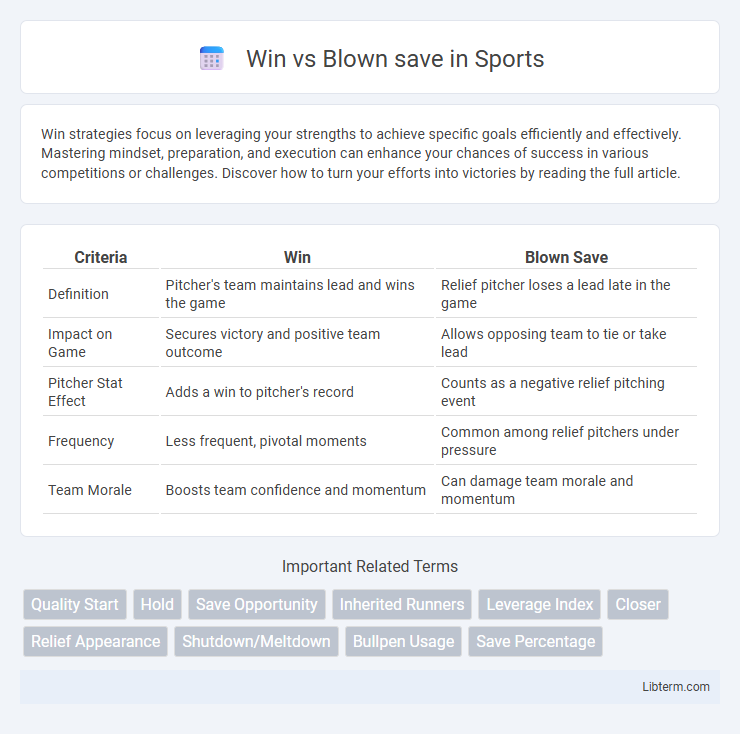Win strategies focus on leveraging your strengths to achieve specific goals efficiently and effectively. Mastering mindset, preparation, and execution can enhance your chances of success in various competitions or challenges. Discover how to turn your efforts into victories by reading the full article.
Table of Comparison
| Criteria | Win | Blown Save |
|---|---|---|
| Definition | Pitcher's team maintains lead and wins the game | Relief pitcher loses a lead late in the game |
| Impact on Game | Secures victory and positive team outcome | Allows opposing team to tie or take lead |
| Pitcher Stat Effect | Adds a win to pitcher's record | Counts as a negative relief pitching event |
| Frequency | Less frequent, pivotal moments | Common among relief pitchers under pressure |
| Team Morale | Boosts team confidence and momentum | Can damage team morale and momentum |
Understanding Wins and Blown Saves in Baseball
Wins in baseball are credited to the starting or relief pitcher who is pitching while their team takes the lead and maintains it, reflecting their effectiveness in securing the game's outcome. Blown saves occur when a relief pitcher enters in a save situation but allows the tying or go-ahead run to score, negatively impacting their save percentage and team momentum. Understanding these statistics helps evaluate a pitcher's performance, especially closers and setup men, under high-pressure scenarios.
Defining the Win: Criteria and Scenarios
A win in baseball is credited to the pitcher who is deemed most effective when their team takes and maintains the lead while they are in the game, especially if they pitch at least five innings as a starter. The official scorer awards the win based on specific criteria, including who was the pitcher of record when the winning run scored. Situations like relief appearances and extra innings can complicate the assignment, but the win is primarily about being the pitcher during the decisive go-ahead run.
What Constitutes a Blown Save?
A blown save occurs when a relief pitcher enters a game in a save situation but allows the tying run to score, failing to maintain the lead. This typically happens if the pitcher surrenders hits, walks, or runs that erase the team's advantage before recording the final out. The statistic is crucial for evaluating a closer's effectiveness in preserving victories under pressure.
Key Differences Between Wins and Blown Saves
A win is credited to a relief pitcher who successfully maintains the lead when entering a game, while a blown save occurs when a relief pitcher allows the tying or go-ahead run to score after inheriting a save situation. Wins are recorded based on the pitcher's effectiveness in preserving the team's advantage, whereas blown saves directly reflect failure to secure a save opportunity. The key difference lies in the outcome of the relief appearance, with wins contributing positively to pitching stats and blown saves negatively impacting them.
How Pitchers Are Credited with Wins
Pitchers are credited with wins when they are the pitcher of record when their team takes the lead for good, typically requiring at least five innings pitched by a starter. In contrast, a blown save occurs when a relief pitcher enters a game with a save opportunity but allows the tying or go-ahead run to score. The official scorer awards a win to the relief pitcher deemed most effective if the starter fails to qualify for the win or the lead changes multiple times.
Common Situations Leading to Blown Saves
A blown save occurs when a relief pitcher enters a game in a save situation but allows the tying or go-ahead run to score, surrendering the lead. Common situations leading to blown saves include runners inherited with no outs who score, bases-loaded struggles resulting in walks or hits, and surrendering home runs that erase a narrow lead. These scenarios often involve high-pressure innings where pitchers fail to maintain control, allowing opponents to capitalize and shift momentum.
Statistical Impact: Wins vs. Blown Saves on Pitcher Performance
Wins significantly enhance a pitcher's overall value by contributing directly to their win-loss record, a key metric in evaluating effectiveness and consistency. Blown saves negatively impact a pitcher's performance metrics, often leading to higher earned run averages (ERA) and decreased save percentages, which can undermine a team's confidence in late-inning situations. The statistical contrast between wins and blown saves offers critical insight into a pitcher's ability to maintain leads and close games successfully.
Strategic Implications for Managers: Win and Save Decisions
Win and blown save decisions significantly impact managerial strategies in baseball, influencing bullpen deployment and game outcomes. Managers must assess reliever performance metrics and game context, such as leverage index and run expectancy, to optimize pitcher usage and maximize win probabilities. Strategic bullpen management based on save situations enhances team resilience and competitive advantage during critical late-inning scenarios.
Notable Wins and Famous Blown Saves in Baseball History
Notable wins in baseball history include iconic moments like Don Larsen's perfect game in the 1956 World Series and Kirk Gibson's dramatic pinch-hit home run in the 1988 World Series. Famous blown saves have significantly shaped baseball lore, with Bill Buckner's error in the 1986 World Series and Jonathan Papelbon's 2012 blown save in the playoffs standing out as pivotal moments. These wins and blown saves highlight the high stakes and unpredictable nature of baseball, where a single play can define a player's legacy and alter the course of championships.
Evaluating Pitcher Value Beyond Wins and Blown Saves
Evaluating pitcher value beyond wins and blown saves requires analyzing advanced metrics such as FIP (Fielding Independent Pitching), WHIP (Walks plus Hits per Inning Pitched), and WAR (Wins Above Replacement) to better capture a pitcher's true performance. Wins and blown saves often depend on team offensive support and bullpen reliability, making them less reliable indicators of individual contribution. Incorporating these comprehensive statistics provides a more accurate assessment of a pitcher's impact on game outcomes and overall team success.
Win Infographic

 libterm.com
libterm.com